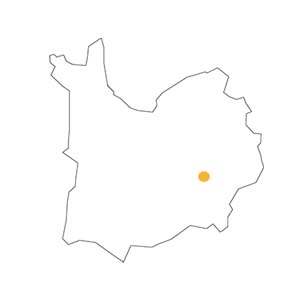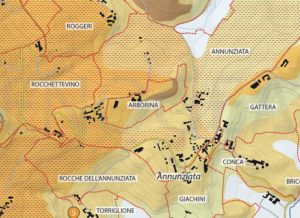Arborina
La Morra
Considering the Annunziata area as a whole and a possible range of styles, if at one extreme we find Conca, with its generous and substantial Barolo wines, at the exact opposite end we find the MGA Arborina, where Barolo even from the hottest vintages stands out from the others for an extra touch of freshness and fruitiness.
That’s somewhat surprising if we consider that this is a rather early ripening cru with exposures ranging from good to very good, and with numerous geological variables within it that in theory should account for as many nuances in the wines. As can be seen in the extract of the geo-viticultural map, the MGA Arborina has three different formations: the laminated Sant’Agata Fossili Marls in the upper part, the sandy Sant’Agata Fossili Marlsi in the medium lower part of the hill, and finally a small outcrop of Diano Sandstones that corresponds to that tuft of trees in the center of the image. Overall there is a decided prevalence of younger soils, with the sole exception being the slope facing Bricco San Biagio, from which, however, there is no Barolo wine on the market today.
A final note on the recommended tastings. Here, more than in other cases, I found it awkward to make choices because every wine produced deserves to be mentioned. So I would like to stress once again: being or not being among recommended wines does not imply any classification of merit.
Recommended tastings
Barolo Arborina – Elio Altare; Barolo Arborina – Renato Corino; Barolo Arborina – Nadia Curto; Barolo Arborina – Mauro Veglio
Reference tastings
Barolo Cerretta Vigna Bricco – Elio Altare; Barolo Monfalletto – Cordero di Montezemolo; Barolo Conca – Renato Ratti; Barolo Gattera – Mauro Veglio




